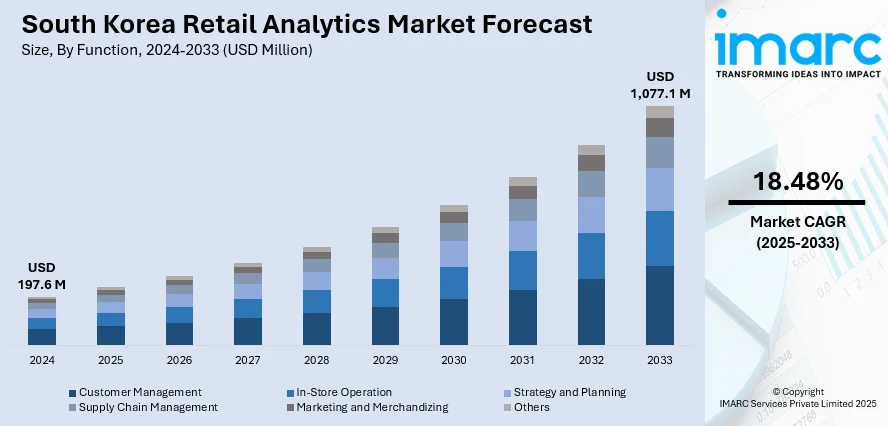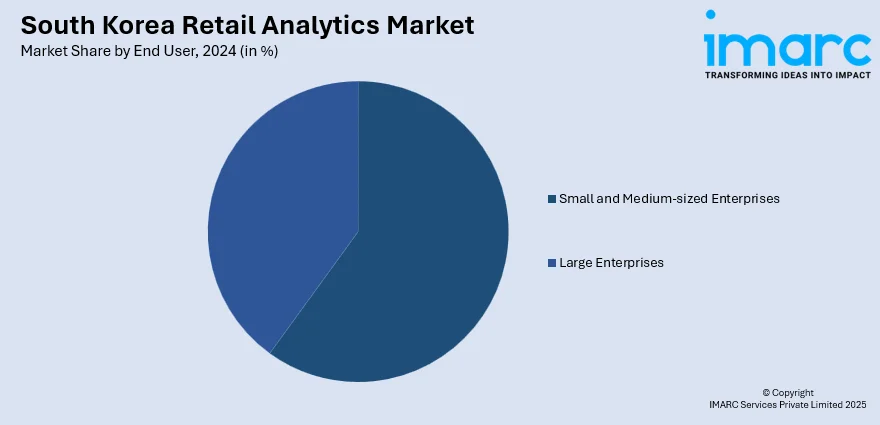
South Korea Retail Analytics Market Size, Share, Trends and Forecast by Function, Component, Deployment Mode, End User, and Region, 2025-2033
South Korea Retail Analytics Market Overview:
The South Korea retail analytics market size reached USD 197.6 Million in 2024. The market is projected to reach USD 1,077.1 Million by 2033, exhibiting a growth rate (CAGR) of 18.48% during 2025-2033. The market is fueled by the surging use of innovative technologies like AI and big data analytics among retailers looking to drive customer experience and operational efficiency. Further, the surging need for personalized retail experiences and real-time insights into data is driving the growth of the market. Also, the rise in e-commerce and the necessity for retailers to optimize supply chain and inventory management further augments the South Korea retail analytics market share.
|
Report Attribute
|
Key Statistics
|
|---|---|
|
Base Year
|
2024
|
|
Forecast Years
|
2025-2033
|
|
Historical Years
|
2019-2024
|
| Market Size in 2024 | USD 197.6 Million |
| Market Forecast in 2033 | USD 1,077.1 Million |
| Market Growth Rate 2025-2033 | 18.48% |
South Korea Retail Analytics Market Trends:
Integration of Artificial Intelligence and Predictive Analytics
South Korean retailers are increasingly using artificial intelligence (AI) and predictive analytics to drive operations and engagement with customers. According to an industry report, the South Korea artificial intelligence market size is expected to reach USD 30.00 Billion by 2033, exhibiting a CAGR of 26.60% from 2025-2033. This indicates a strong shift toward technology-driven retail strategies. In the retail analytics sector, AI helps businesses optimize inventory management, forecast demand with greater accuracy, and deliver tailored marketing solutions. In addition, predictive models enable retailers to predict customer behavior based on buying history, seasonality, and browsing habits, enabling them to make more focused promotions and minimize stockouts or overstock scenarios. Additionally, recommendation systems powered by AI are now ubiquitous on e-commerce sites and omnichannel retail networks. These systems process vast amounts of consumer data in real time, enabling companies to offer products that resonate with customers' tastes, enhancing conversion rates. The retailers are also using predictive analytics for labor optimization by predicting busy shopping hours and scheduling accordingly. This not only enhances the productivity of retail operations but also enhances customer satisfaction by shortening waiting times and enhancing service quality. This trend is significantly facilitating the South Korea retail analytics market growth.

To get more information on this market, Request Sample
Rise of Omnichannel Retail Strategies and Unified Customer Insights
The retail landscape in South Korea is undergoing a significant transformation as businesses increasingly adopt omnichannel strategies to address changing consumer requirements. Shoppers today engage with brands through various modes, such as physical stores, websites, mobile apps, and social media, requiring retailers to deliver a seamless and consistent experience throughout. As per an industry report, the country's e-commerce retail transactions surged to a record 227 Trillion Korean won in 2023, supported by a strong compound annual growth rate of around 20% over the past ten years. As retailers increasingly operate across multiple platforms, the demand for advanced retail analytics solutions has intensified. These tools are being adopted to consolidate customer data from all touchpoints into an integrated framework, enabling a holistic view of consumer behavior and more strategic, data-informed decision-making. These integrated systems allow retailers to track the complete customer journey, enabling insights into purchase behavior, channel preferences, and engagement levels. Retailers can then use this information to tailor marketing campaigns, enhance loyalty programs, and personalize the shopping experience. For example, a customer who browses online but prefers to purchase in-store can receive location-based offers or in-app reminders, increasing the likelihood of conversion. The trend toward omnichannel analytics also supports improved inventory synchronization, ensuring product availability across all platforms. This convergence of digital and physical retail, supported by robust analytics, is becoming a cornerstone of competitive strategy in the market.
South Korea Retail Analytics Market Segmentation:
IMARC Group provides an analysis of the key trends in each segment of the market, along with forecasts at the country and regional levels for 2025-2033. Our report has categorized the market based on function, component, deployment mode, and end user.
Function Insights:
- Customer Management
- In-Store Operation
- Strategy and Planning
- Supply Chain Management
- Marketing and Merchandizing
- Others
The report has provided a detailed breakup and analysis of the market based on the function. This includes customer management, in-store operation, strategy and planning, supply chain management, marketing and merchandizing, and others.
Component Insights:
- Software
- Services
A detailed breakup and analysis of the market based on the component have also been provided in the report. This includes software and services.
Deployment Mode Insights:
- On-premises
- Cloud-based
The report has provided a detailed breakup and analysis of the market based on the deployment mode. This includes on-premises and cloud-based.
End User Insights:

- Small and Medium-sized Enterprises
- Large Enterprises
A detailed breakup and analysis of the market based on the end user have also been provided in the report. This includes small and medium-sized enterprises and large enterprises.
Regional Insights:
- Seoul Capital Area
- Yeongnam (Southeastern Region)
- Honam (Southwestern Region)
- Hoseo (Central Region)
- Others
The report has also provided a comprehensive analysis of all the major regional markets, which include Seoul Capital Area, Yeongnam (Southeastern Region), Honam (Southwestern Region), Hoseo (Central Region), and others.
Competitive Landscape:
The market research report has also provided a comprehensive analysis of the competitive landscape. Competitive analysis such as market structure, key player positioning, top winning strategies, competitive dashboard, and company evaluation quadrant has been covered in the report. Also, detailed profiles of all major companies have been provided.
South Korea Retail Analytics Market Report Coverage:
| Report Features | Details |
|---|---|
| Base Year of the Analysis | 2024 |
| Historical Period | 2019-2024 |
| Forecast Period | 2025-2033 |
| Units | Million USD |
| Scope of the Report |
Exploration of Historical Trends and Market Outlook, Industry Catalysts and Challenges, Segment-Wise Historical and Future Market Assessment:
|
| Functions Covered | Customer Management, In-Store Operation, Strategy and Planning, Supply Chain Management, Marketing and Merchandizing, Others |
| Components Covered | Software, Services |
| Deployment Modes Covered | On-premises, Cloud-based |
| End Users Covered | Small and Medium-sized Enterprises, Large Enterprises |
| Regions Covered | Seoul Capital Area, Yeongnam (Southeastern Region), Honam (Southwestern Region), Hoseo (Central Region), Others |
| Customization Scope | 10% Free Customization |
| Post-Sale Analyst Support | 10-12 Weeks |
| Delivery Format | PDF and Excel through Email (We can also provide the editable version of the report in PPT/Word format on special request) |
Key Questions Answered in This Report:
- How has the South Korea retail analytics market performed so far and how will it perform in the coming years?
- What is the breakup of the South Korea retail analytics market on the basis of function?
- What is the breakup of the South Korea retail analytics market on the basis of component?
- What is the breakup of the South Korea retail analytics market on the basis of deployment mode?
- What is the breakup of the South Korea retail analytics market on the basis of end user?
- What is the breakup of the South Korea retail analytics market on the basis of region?
- What are the various stages in the value chain of the South Korea retail analytics market?
- What are the key driving factors and challenges in the South Korea retail analytics market?
- What is the structure of the South Korea retail analytics market and who are the key players?
- What is the degree of competition in the South Korea retail analytics market?
Key Benefits for Stakeholders:
- IMARC’s industry report offers a comprehensive quantitative analysis of various market segments, historical and current market trends, market forecasts, and dynamics of the South Korea retail analytics market from 2019-2033.
- The research report provides the latest information on the market drivers, challenges, and opportunities in the South Korea retail analytics market.
- Porter's five forces analysis assist stakeholders in assessing the impact of new entrants, competitive rivalry, supplier power, buyer power, and the threat of substitution. It helps stakeholders to analyze the level of competition within the South Korea retail analytics industry and its attractiveness.
- Competitive landscape allows stakeholders to understand their competitive environment and provides an insight into the current positions of key players in the market.
Need more help?
- Speak to our experienced analysts for insights on the current market scenarios.
- Include additional segments and countries to customize the report as per your requirement.
- Gain an unparalleled competitive advantage in your domain by understanding how to utilize the report and positively impacting your operations and revenue.
- For further assistance, please connect with our analysts.
 Request Customization
Request Customization
 Speak to an Analyst
Speak to an Analyst
 Request Brochure
Request Brochure
 Inquire Before Buying
Inquire Before Buying




.webp)




.webp)












